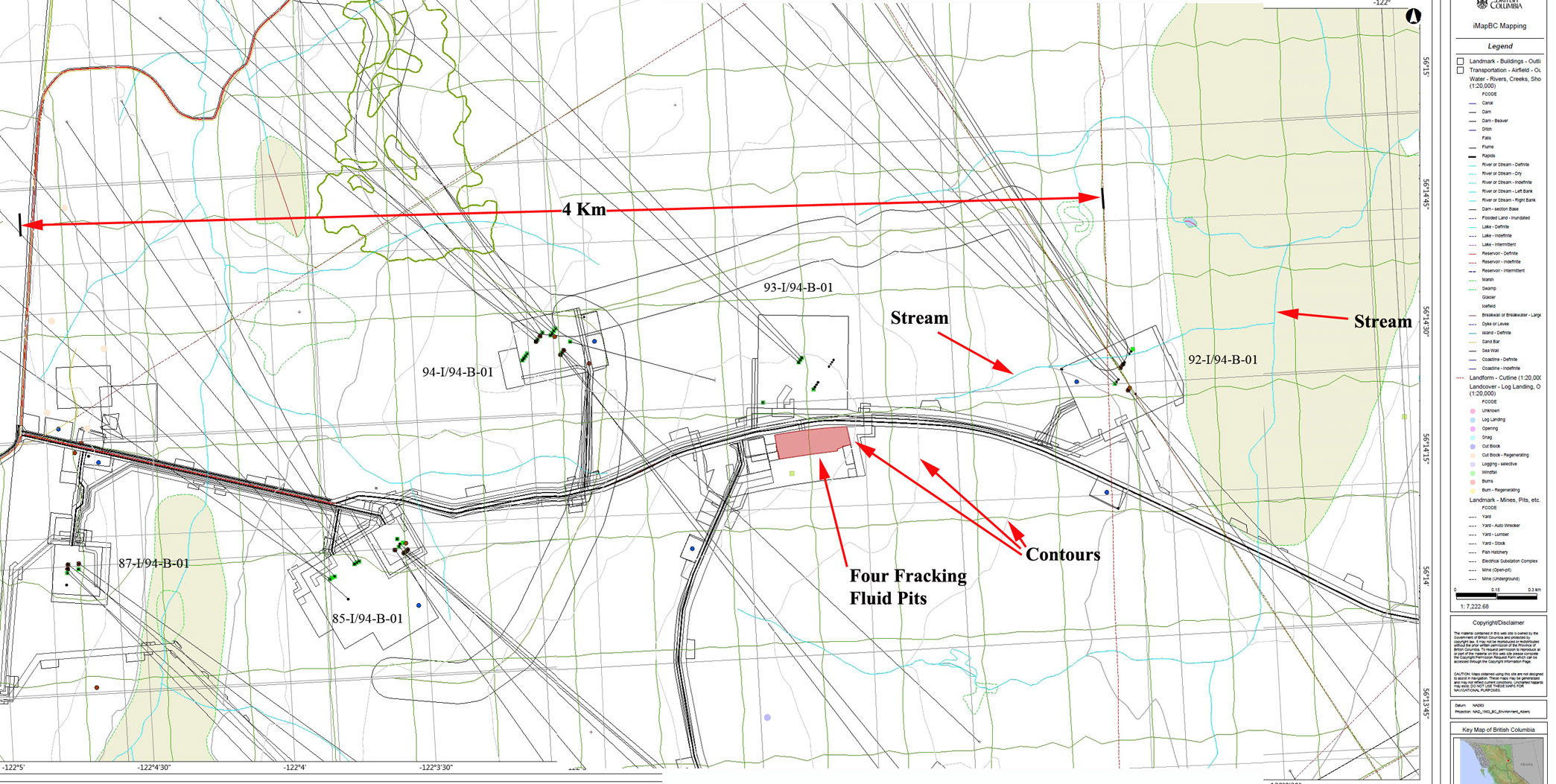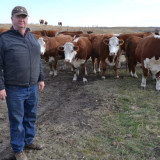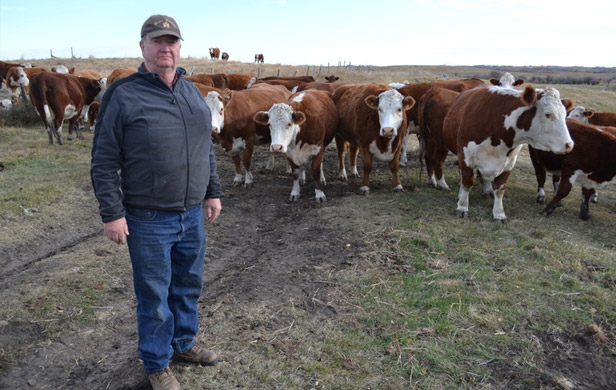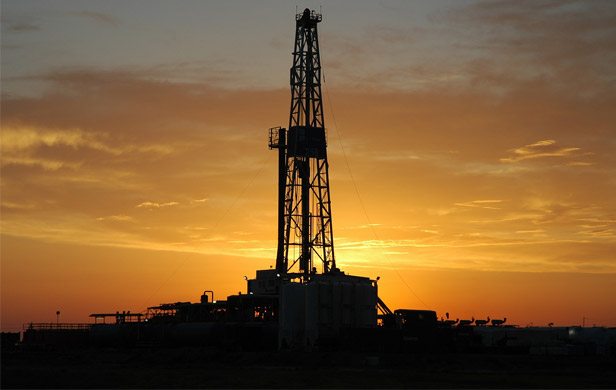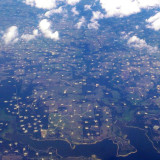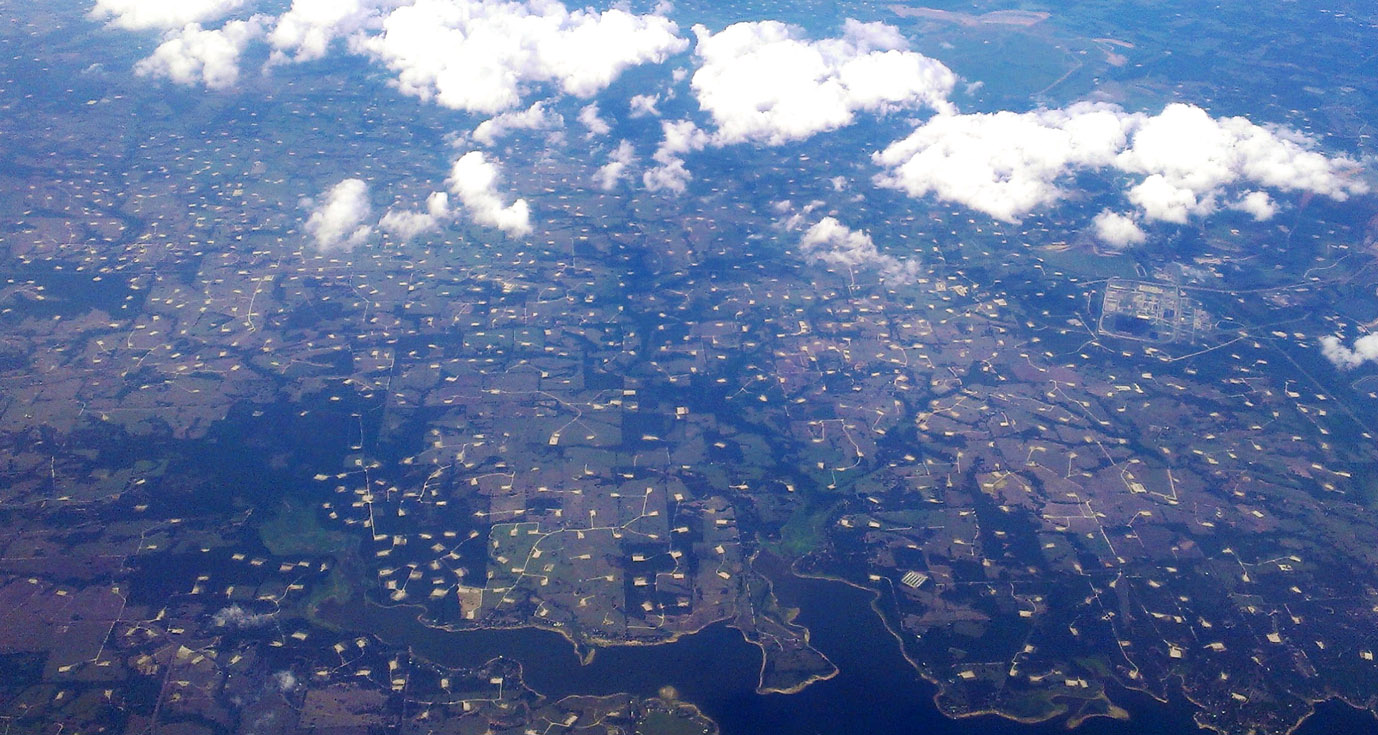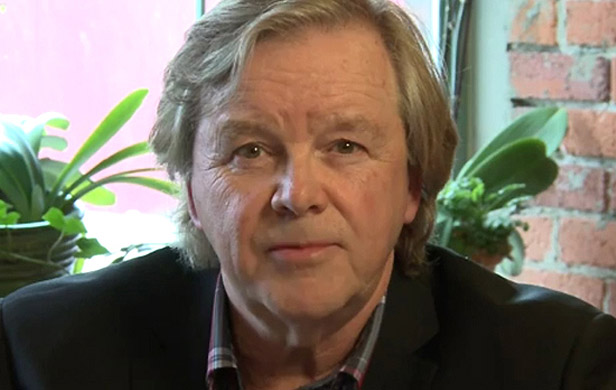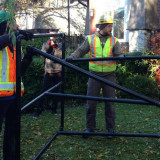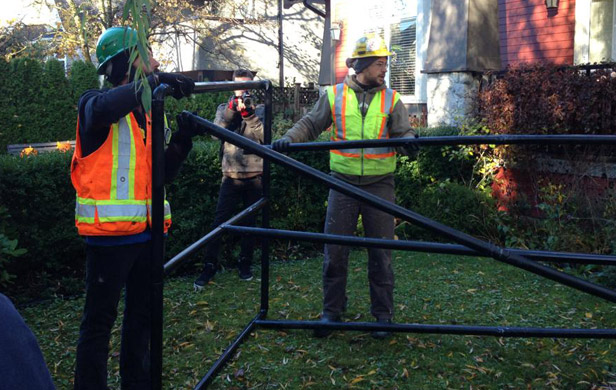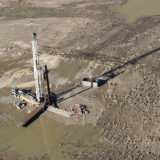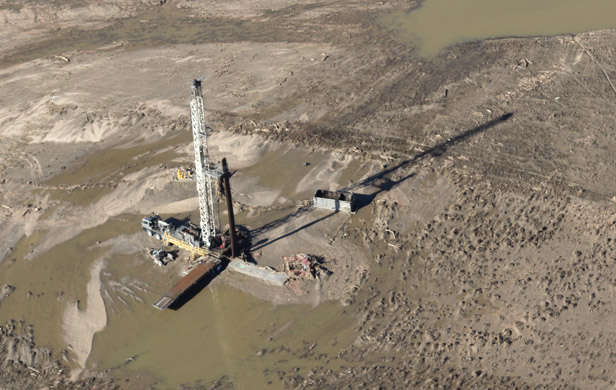
by Damien Gillis and Will Koop
A pit storing contaminated fracking water in northeast BC was leaking into the surrounding soil and groundwater for up to six months before owner Talisman formally notified the Oil and Gas Commission and undertook clean-up efforts, The Common Sense Canadian has learned.
One of five lined pits connected to Talisman’s Farrell Creek operations north of Hudson’s Hope, referred to as Pond A, suffered a puncture through both of its protective layers, causing toxic fluids to begin escaping into the environment. The pits are used to store “produced water” from previous fracks to be reused later as part of a program to cut back on freshwater use. Ironically, this practice has now threatened local groundwater due to the ruptured liners.
It has proven difficult to obtain straight answers from the regulator or company, but through a series of recent communications, we have been able to piece together a rough timeline of the incident.
Holes in Talisman’s liner, story
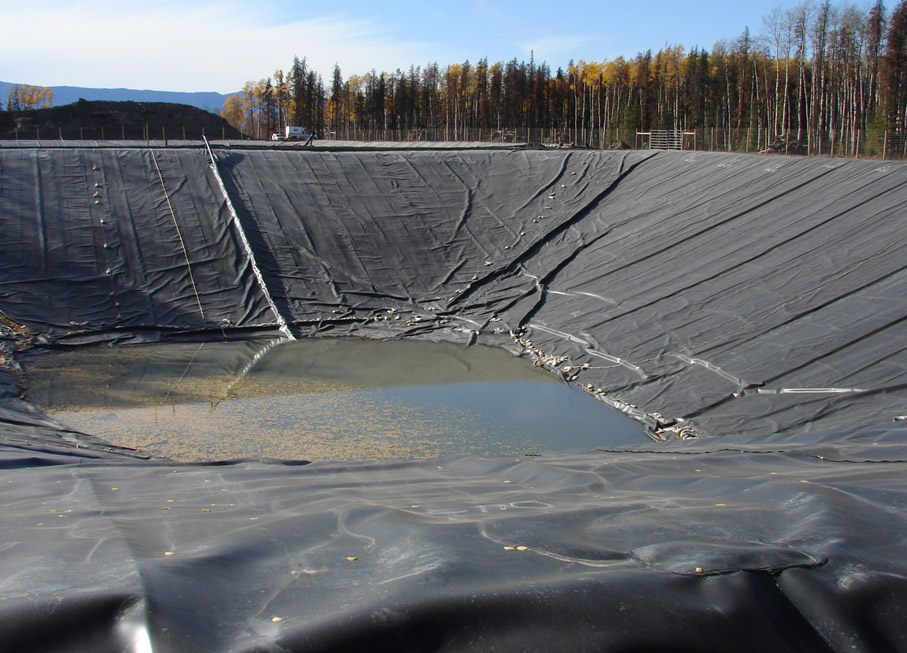
Talisman’s storage pits consist of two liners with a a layer of interstitial webbing in between. As Talisman Community Engagement Advisor Dan Glover explained this past Friday over the phone, that webbing contains sensors which detected a leak in the inside membrane during a routine inspection in “late January” of this year.
“What we didn’t pick up at that time was that there was also an issue with the second liner,” added Glover.
“From what I understand, we started draining the pond in late January when the leak was detected, but it didn’t happen quickly,” he acknowledged.
[quote]That’s a lot of water to truck away.
[/quote]
Indeed, Pond A holds approximately 30,000 cubic metres (30 million litres) of fluids at capacity. With the three neighbouring pits full, the company had to pump out Pond A by tanker truck, removing the toxic liquid waste to the Silverberry industrial waste transfer site, some 70 km away. Each truck can carry just 30-36 cubic metres, meaning almost 1,000 truck loads to empty the pit (and about 120,000-140,000 total km of travel).
That said, the above aerial image of the pits, taken on March 28, conflicts with Mr. Glover’s statement that the company began emptying the pond back in January after the sensors detected a leak in the inner membrane. At least two months later, there is no visible sign that the company has even begun pumping out Pond A.
Getting to the bottom of Pond A leak
It is unclear when Talisman did begin emptying the pit, but Mr. Glover claims it was fully drained by the beginning of June, after which the company removed the liners and discovered the outer layer had failed too, meaning the pit had been leaking for close to 5 months into the soil and groundwater at that point.
In a November 8 email to Hudson’s Hope Mayor Gwen Johansson, responding to questions from a concerned community member, Glover said, “…in June we informed the OGC that we were taking the pond out of service.” Yet, in an advisory emailed to media last week, the regulator stated, “The BC Oil and Gas Commission is investigating a leak in a Talisman frackwater storage pond that was reported by the company on July 22, 2013.”
We asked Mr. Glover to account for the discrepancy between to two conflicting dates when the spill was reported to the OGC. He explained that the first notification, in June, was an informal “heads-up” from Talisman’s regulatory compliance officer. The July date constitutes the company’s “official self-disclosure” to the regulator.
It would take another two and a half months for the OGC to issue a formal order to Talisman “to delineate the extent of soil and groundwater impact in and around Pond A and provide the results to the OGC,” according to Glover. The OGC has declined repeated requests to furnish us with a copy of the order, but has acknowledged the date was October 4 – with a deadline of November 29 for more detailed reporting of remediation and test results on the soil and groundwater.
The above sequence illustrates some serious gaps in the regulatory framework for the industry, with companies left to self-report such incidents, and an apparent lack of urgency on the part of the OGC for mandating and monitoring emergency clean-up measures.
First Nations upset at lack of disclosure
Chief Roland Wilson of West Moberly First Nations, on whose shared territory the leak occurred, is upset at the lack of disclosure by Talisman and the OGC. He says that dialogue with both entities only began once the Nation initiated it, after hearing about learning of the leak through other sources. “They didn’t come forward with anything. That’s a big concern,” says Wilson.
[quote]We have people on the ground – hunters, people practicing their treaty rights. Is this getting into the creeks where they’re camping? Who knows what’s happening? The OGC has the duty to consult. When there is a possible threat to the safety of our members, it’s their duty to inform us.[/quote]
Talisman also neglected to inform West Moberly of the incident, in spite of a memorandum of understanding between the Nation and company which mandates open dialogue. Mr. Glover doesn’t dispute this point. However, when asked why the company didn’t inform First Nations of the leak in January when it was first detected, he suggests it didn’t yet have enough information to share without further investigation.
[quote]We didn’t want to go to them and say, ‘hey guys, we have an issue with one of our ponds,’ then they would ask, ‘what’s the issue?’ and we would have told them we have no idea.[/quote]
That said, there remains the apparent contradiction between the company’s timeline for draining the pit and the above photographic evidence, which suggests Talisman’s response was far less prompt than it has portrayed.
Mr. Glover says that once First Nations contacted Talisman with concerns about the leaking pit, they were invited for a site inspection. He also maintains the company will share its reports on the clean-up with First Nations throughout the region going forward.
Liners punctured by shale

Talisman believes the pit’s liners were punctured by a chunk of shale protruding from the surrounding soil, in the bottom third of the 12 metre-deep cavity.
Following the draining of the pit, Talisman hired Highmark Environmental Services to remove contaminated soil and Matrix Solutions for groundwater monitoring. Results from preliminary testing were supplied to the OGC on September 16, along with an initial remediation plan, which Highmark began to implement. As of last week, an estimated 4,600 cubic metres of soil had been removed and trucked to the Silverberry facility – with approximately 300 cubic metres of contaminated soil remaining to be removed.
The work is ongoing, with follow up meetings being planned in the coming weeks between Talisman and the regulator to review the company’s progress and further testing results.
Chemicals, contamination largely unknown
The company has been unclear about the nature of contaminants in the frackwater, only acknowledging the presence of chlorides, sodium and dissolved solids. In his email to the Hudson’s Hope mayor, Mr. Glover pointed to the province’s “FracFocus” tool, a database where companies operating in BC are now mandated to file chemicals used in their fracks. However, companies are allowed to keep trade secrets and use other tricks to avoid full disclosure.
For instance, we examined the FracFocus list of ingredients used in Well 93-i of the Altares field, directly across the road from the frack fluid storage pits, as an example of the toxics potentially contained in Pond A. While contractor Schlumberger lists most of the chemicals it used in the well, it leaves out some critical details and product information (known as CAS Registry Numbers). And since the FracFocus tool has only been in place since November 2011 in BC, there is data missing for a number of older wells.
For example, Talisman only reports chemicals used in 73 out of 111 of its wells in the Altares field. The company’s total data for the 73 Altares wells indicates it used 993,832 cubic metres (almost a billion litres) of water for fracking purposes – and about 10,000 cubic metres (10 million litres) of toxic additives.
Moreover, the FracFocus tool does not include drilling additives, which, as revealed in a recent peer-reviewed, published paper, can be just as dangerous as fracking fluids.
In any event, here are just a few of the chemicals disclosed by contractor Schlumberger at Talisman’s well (view the full list here):
- Hydrochloric Acid
- Distillates (petroleum)
- Sodium hydroxide (impurity)
- 2-Methyl-4-isothiazolin-3-one
- Trisodium nitrilotriacetate (impurity)
We asked Calgary-based Talisman spokesperson Berta Gomez specifically if the water contained the known carcinogen benzene, to which she replied via email, “Yes the produced water does contain low level concentrations of Benzene. Our sampling has shown an average concentration of 0.465 mg/L with a range of 0.211 – 0.824 mg/L,” though she maintains that’s well below the allowable concentration under BC’s Contaminated Sites Regulations.
Finally, neither the OGC nor Talisman have yet to reveal to the public the naturally occurring toxics released within the fracked flow back water – such as mercury, arsenic, barium, strontium, chromium, BTEX (benzene, toluene, ethylbenzene, xylenes), radium, uranium, and whatever other dangerous underground substances are being dredged up by fracking (read our recent story about dead cows and radiation connected to fracking near a farm in Alberta).
Volume of leaked frackwater unknown
According to the OGC, “The volume of fluid leaked [from Pond A] at this point has not been determined.”
Of particular concern is the indication on a provincial mapping service, iMap BC, that a stream runs near the four waste pits (shown on the graphic below) – which are perched at the top of a hill. Pond A rests at the eastern edge nearest the downhill slope. The company maintains the penetration of fluids into the soil has been limited to .75 metres in depth and Mr. Glover says there is no visible stream in that location. That said, government data suggests otherwise and the location of the pond at the top of a hill is cause for concern.
Government claims zero water contamination from fracking
The incident is highly inconvenient for industry and government on a number of fronts, as the BC Liberal Government tries to calm environmental concerns in its push to build an LNG industry on BC’s coast.
BC Minister for Natural Gas Rich Coleman penned an op-ed in The Georgia Straight one week after the story of Talisman’s leak was broken by The Globe and Mail, boldly declaring:
[quote]The net result of both our strong regulatory framework and our geology is that B.C.’s water supply is protected and safe. It has never been contaminated as a result of hydraulic fracturing.[/quote]
OGC spokesperson Hardy Friedrich echoed these comments to the media as late as last week, on November 13, stating “Water has never been contaminated as a result of hydraulic fracturing in B.C.”
And yet, both the OGC and Talisman acknowledge there has been groundwater contamination here from the leaking Pond A. The regulator was also quick to defend the industry’s record in its media lines surrounding the leak, stating, “There have been no similar incidents in 2013. There is only one similar instance in the past five years. It occurred in 2011. In that incident the leak was immediately detected, the storage pond drained and the area remediated.”
It is nevertheless incorrect to state that water has never been contaminated from fracking in BC. Moreover, as this incident demonstrates, the regulatory system in place isn’t designed to detect contamination, so we have no real sense of how many other incidents have gone undetected or unreported. As of 2012, the OGC had all of ONE hydrologist on staff.
Talisman’s shale for sale
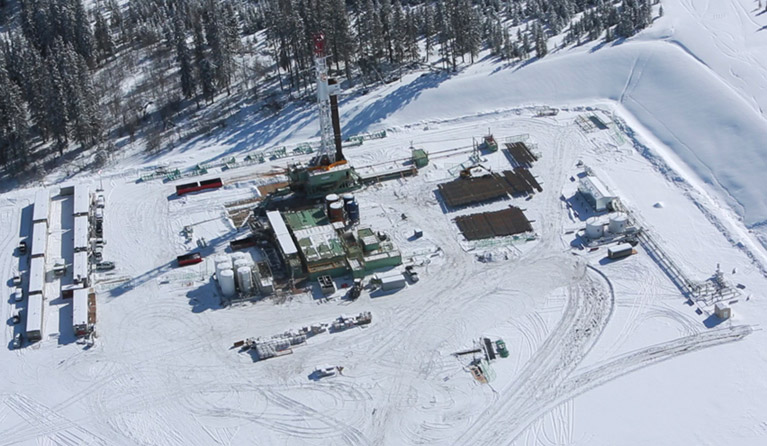
This incident also comes amidst the planned sale of most of Talisman’s Montney shale gas assets to Progress Energy – a subsidiary of Malaysian energy giant and would-be BC LNG player Petronas – for $1.5 Billion. The deal involving Talisman’s Farrell Creek and Cypress operations was announced on November 8 and is expected to conclude sometime in the new year.
It would appear the Pond A incident is alreading weighing on prospective owner Progress/Petronas’ mind. Following initial conversations last week about the leaking pond, Talisman spokesperson Berta Gomez told us via email, “Since the Progress/Talisman deal was announced, we need to get approval from them for any media response we provide on any issue that involves them. Can I ask you please to hold the publication of the interview you did to me until I get responses approved by Progress?”
Chief Wilson is worried about the pending handover from Talisman to Progress/Petronas and how that will impact the remediation of Pond A and relations with his community around economic and environmental issues:
[quote]This poses a concern for us because we don’t have any kind of a working relationship with Progress. We don’t know if they’re going to honour our Memorandum of Understanding with Talisman, or the employment opportunities we’ve been working on with them for our members. What’s going to happen now?[/quote]
Mr. Glover says Talisman is aiming to have clean-up completed by year-end, but that doesn’t include any final decision about what to do with the pond beyond that.
Water Act, fracking lawsuit
The Pond A incident also comes as a lawsuit was announced this week by Ecojustice and two BC-based environmental groups over the issuance of water permits for fracking. The filing of the case in the BC Supreme Court coincides with the call for public feedback into the modernization of BC’s antiquated Water Act, which concluded this past Friday.
Clearly, the Talisman leak has revealed holes in more than just the company’s storage pit liners. These gaps in BC’s regulatory framework need to be addressed with the new Water Sustainability Act. The incident also poses somes tough questions for a government that wants to dramatically ramp up fracking to feed proposed liquefied natural gas (LNG) plants on BC’s coast, yet doesn’t seem prepared to acknowledge the risks the controversial practice poses on the ground.


